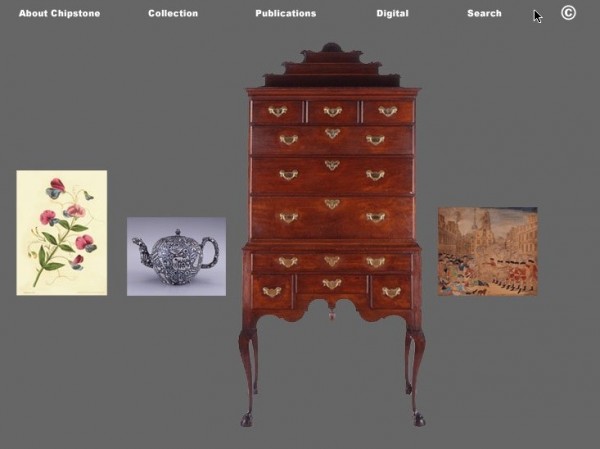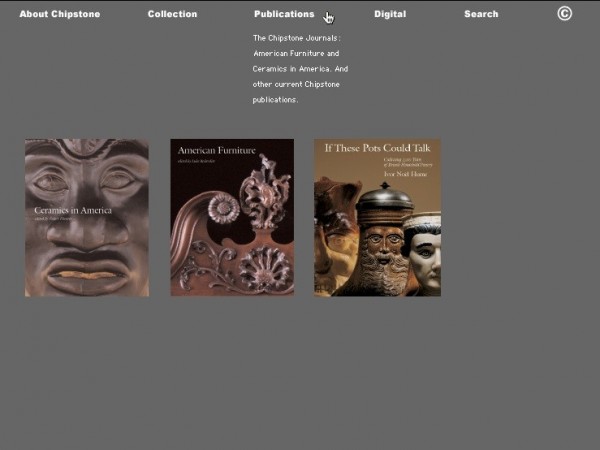
Current home page from Chipstone.org.

Current publications page from Chipstone.org.

A page from the Chipstone website documenting a former Chipstone exhibit at the Milwaukee Art Museum: If These Pots Could Talk, an exhibit of the Ivor Noël Hume Collection of Ceramics.

A page from the Chipstone website documenting another former Chipstone exhibit at the Milwaukee Art Museum: Skin Deep, an exhibit of inlay furniture.
With the publication of American Furniture 2003, the Chipstone Foundation continues its institutional mission to promote scholarship in the field of American decorative arts. The current issue oVers a rich array of essays that cover many pertinent topics. As in the past, such diversity is by design. Luke Beckerdite, former executive director of Chipstone, first created the journal in 1993 and since then has served as editor. Throughout his tenure, Beckerdite has purposefully merged essays about the more iconic topics in American furniture study with newer analyses and interpretations that have helped to expand the canon of American furniture forms, makers, institutions, and collections. The journal encourages work from established furniture historians and also from younger scholars. Many of the rising figures in the field today got their publishing start in American Furniture. The widely acclaimed journal Ceramics in America, created in 2001 by Editor Rob Hunter, further demonstrates Chipstone’s educational priorities and its support of innovative work in the field.
The year 2004 will see Chipstone’s publication of American Fancy: Exuberance in the Arts, 1790–1840 by decorative arts scholar and dealer Sumpter Priddy. Both in form and content, this groundbreaking study is an exciting addition to the existing body of literature on American furniture. The release of the book parallels the opening of a corresponding exhibit at the Milwaukee Art Museum (April 3–July 3, 2004). The show then will travel to the newly renovated galleries at the Peabody Essex Museum (July 7–October 31, 2004) and to the Maryland Historical Society (December 3, 2004–March 20, 2005). Priddy’s study introduces the significant and, to date, curiously overlooked story of Fancy. As much a cultural attitude as a style in the arts, perfectly of its time and place, Fancy stimulated the visual and emotional experience of early Americans and enlivened the look of American homes and public spaces alike. The new book, as well as the exhibit, is informed by many diVerent disciplines—philosophy, art history, aesthetics, gender studies, intellectual history, and economic history—all of which are essential to any informed and well rounded understanding of American Fancy. In this regard, Priddy provides the decorative arts field with an innovative interpretive methodology that necessarily transcends the traditional realms of connoisseurship and quantification, and is customized to meet the needs of his complex topic. American Fancy: Exuberance in the Arts, 1790–1840 echoes the progressive and transdisciplinary trends that are forwarding work in all other areas of the humanities.
Chipstone publications of yet another sort enliven the foundation’s website, <www.chipstone.org>. Guided by the creative hand of Wynne Patterson, webmaster, this site explores the potential of various digital forms of decorative arts scholarship. To date, the emphasis in many American museum and foundation websites has been to oVer an overview of the institution and, in fewer instances, to give partial scholarly access to artifacts in the collections. But new expectations on the part of both the public and younger specialists in the field are sparking more aggressive exploration of the digital realm. A growing number of organizations are actively seeking ways to further their educational programs by making collections available through the creation of more complete visual and information databases, which at last oVer scholarly access to information that traditionally has been tucked away in curator work sheets and museum accession files. Chipstone.org now oVers fuller access to the foundation’s furniture holdings via a searchable and updateable database designed by a team of digital experts at the University of Wisconsin at Madison, and soon the ceramics collection will be online as well. For better or worse, many other organizations are feeling the same pressure to present this type of catalog online instead of on paper—in part because of its ability to be modified and augmented down the road, and also because of the significantly reduced cost and greater public access. Chipstone.org also is investigating the relatively new realm of virtual exhibits, which promise to give longer life to museum installations that in the past disappeared from sight forever after their brief gallery runs. Virtual exhibits eVectively preserve the disciplined work of American decorative arts curators and provide a creative teaching alternative for university professors who now can move from conventional slide presentations to online explorations of web-based databases, articles, and exhibits.
In short, Chipstone is pleased to be a part of the evolving character of the American decorative arts world through the support of progressively minded publications and through the investigation of new technological alternatives. Few would argue with the basic fact that over the past several decades the trajectory of cultural studies—including furniture history—has advanced considerably and will undoubtedly continue to do so in the years to come. The role of American decorative arts museums and publishers is to figure out how to contribute to this exciting evolution.
